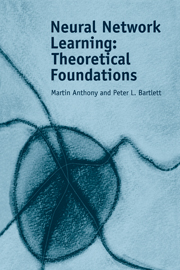
-
Select format
-
- Publisher:
- Cambridge University Press
- Publication date:
- February 2010
- November 1999
- ISBN:
- 9780511624216
- 9780521573535
- 9780521118620
- Dimensions:
- (228 x 152 mm)
- Weight & Pages:
- 0.679kg, 404 Pages
- Dimensions:
- (229 x 152 mm)
- Weight & Pages:
- 0.59kg, 404 Pages
You may already have access via personal or institutional login
Book description
This book describes theoretical advances in the study of artificial neural networks. It explores probabilistic models of supervised learning problems, and addresses the key statistical and computational questions. Research on pattern classification with binary-output networks is surveyed, including a discussion of the relevance of the Vapnik–Chervonenkis dimension, and calculating estimates of the dimension for several neural network models. A model of classification by real-output networks is developed, and the usefulness of classification with a 'large margin' is demonstrated. The authors explain the role of scale-sensitive versions of the Vapnik–Chervonenkis dimension in large margin classification, and in real prediction. They also discuss the computational complexity of neural network learning, describing a variety of hardness results, and outlining two efficient constructive learning algorithms. The book is self-contained and is intended to be accessible to researchers and graduate students in computer science, engineering, and mathematics.
Reviews
‘The book is a useful and readable mongraph. For beginners it is a nice introduction to the subject, for experts a valuable reference.’
Source: Zentralblatt MATH
Contents
Metrics
Altmetric attention score
Full text views
Full text views help Loading metrics...
Loading metrics...
* Views captured on Cambridge Core between #date#. This data will be updated every 24 hours.
Usage data cannot currently be displayed.
Accessibility standard: Unknown
Why this information is here
This section outlines the accessibility features of this content - including support for screen readers, full keyboard navigation and high-contrast display options. This may not be relevant for you.
Accessibility Information
Accessibility compliance for the PDF of this book is currently unknown and may be updated in the future.


